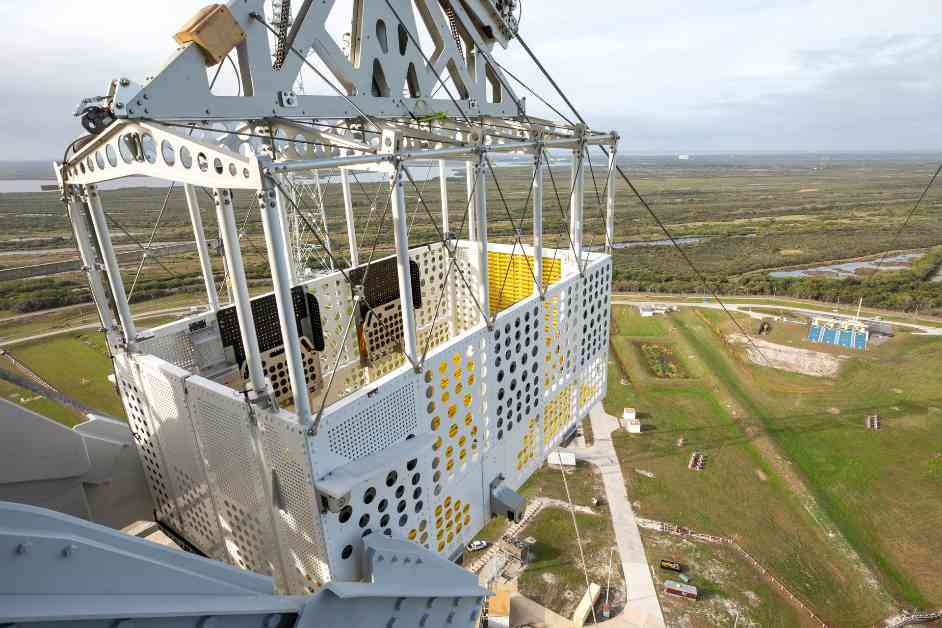NASA’s efforts to ensure the safety of Artemis crew members during emergency situations have taken a significant step forward with the implementation of new brake upgrades. Recently, teams from NASA’s Exploration Ground Systems (EGS) Program at Kennedy Space Center collaborated with engineering experts from a central Florida amusement park to enhance the braking system used for the launch pad emergency egress system for Artemis missions.
The Artemis emergency egress system features a cutting-edge magnetic braking system that NASA has not previously utilized in its ground infrastructure to support launches. Jesse Berdis, the mobile launcher 1 deputy project manager for EGS, highlighted the groundbreaking nature of this technology, stating, “We have a new magnetic braking system for the Artemis emergency egress system, and NASA hasn’t used this technology on the ground infrastructure side before to support launches.” Recognizing the proximity of magnetic braking system experts in Orlando, just 50 miles away from Kennedy Space Center, Berdis emphasized the value of collaborating with industry leaders to optimize crew safety.
In the context of Artemis missions, the emergency egress system utilizes a track cable that connects the mobile launcher to the terminus site near the perimeter of Launch Pad 39B. At this site, four baskets, resembling gondola lifts, are utilized for personnel evacuation in the event of an emergency. The magnetic braking system plays a crucial role in controlling the acceleration of the baskets under varying weight and environmental conditions, ensuring a safe descent to the pad terminus site where armored emergency response vehicles await to transport personnel to a designated safe location within Kennedy Space Center.
While the application of magnetic braking systems on roller coasters differs slightly from NASA’s use for Artemis, the underlying concept remains the same. Amanda Arrieta, the mobile launcher 1 senior element engineer, explained the parallels between the two systems, noting that both leverage magnetics to facilitate controlled deceleration. However, unlike roller coasters that operate daily for extended periods, the Artemis emergency egress system is reserved for emergency scenarios, with minimal operational usage beyond testing and maintenance activities.
Berdis underscored the long-term viability of the magnetic braking system for Artemis missions, emphasizing the importance of proactive maintenance and operational preparedness. Drawing insights from the amusement park’s maintenance practices, Kennedy’s operations teams gained valuable knowledge on conducting nightly, monthly, and yearly inspections to ensure the system’s reliability. The collaborative exchange also led to suggestions such as incorporating an acceleration sensor in the emergency egress baskets during testing to monitor descent speeds effectively.
The emergency egress system represents one of several enhancements introduced by the EGS team to bolster the readiness for future crewed missions, starting with Artemis II. This system exemplifies NASA’s unwavering commitment to crew safety, especially in high-stakes emergency scenarios. Berdis reiterated the mission-critical nature of protecting astronauts and support teams during launch pad emergencies, underscoring the agency’s dedication to thorough risk assessment and mitigation strategies.
During the Space Shuttle Program era, a mechanical braking system was employed for the escape route utilized by astronauts and personnel in the event of launch countdown emergencies. In contrast to the magnetic braking system utilized for Artemis, the Space Shuttle Program’s system relied on a catch net and drag chain mechanism to decelerate and halt the baskets sliding down the wire. The evolution towards magnetic braking systems reflects NASA’s continuous pursuit of enhancing safety measures and operational efficiency.
In the realm of commercial spaceflight, SpaceX, Boeing, and United Launch Alliance have also implemented unique emergency egress systems tailored to their launch facilities. SpaceX utilizes a catch net and drag chain for its slidewire cable at Launch Complex 39A, while Boeing and United Launch Alliance deploy seats on slidewires akin to a zipline descent at Cape Canaveral Space Force Station. These diverse approaches underscore the adaptability of emergency egress systems to suit the specific needs and operational requirements of different space launch providers.
Under the ambitious Artemis campaign, NASA aims to establish a sustainable framework for scientific exploration on the Moon, culminating in the historic landing of the first woman, first person of color, and first international partner astronaut on the lunar surface. This milestone achievement sets the stage for future human expeditions to Mars, underscoring NASA’s enduring commitment to advancing space exploration for the benefit of humanity.
Subheadings


